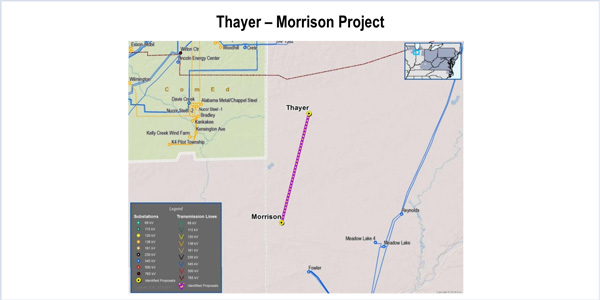By Amanda Durish Cook
MISO and PJM have withdrawn their support for developing the lone interregional market efficiency project to emerge from the RTOs’ two-year coordinated system plan, stakeholders learned Friday.
The proposed 30-mile, 138-kV line between Northern Indiana Public Service Co.’s Thayer and Morrison substations near the Indiana-Illinois border was expected to cost $61.8 million and be in service by December 2022. NIPSCO’s early estimates pegged the cost at $42.5 million. (See “MISO-PJM Coordinated System Plan Produces One Project,” FERC Conditionally OKs MISO-PJM Targeted Project Plan.)
The project was the only one of eight stakeholder-originated suggestions to initially pass the RTOs’ benefit-cost criteria, but it ultimately failed a joint 5% generation-to-load-distribution factor (GLDF) test, which requires each RTO to show that one of its generators has at least a 5% impact on the affected flowgate. PJM did not meet the threshold.
During an Oct. 20 Interregional Planning Stakeholder Advisory Committee conference call, NIPSCO’s Matt Holtz said the addition of the GLDF test essentially equates to a joint benefit test that FERC ordered the RTOs to eliminate from their “triple hurdle,” which included their separate regional benefit tests. He expressed disappointment that both RTOs would withdraw support from the project when “just using the regional processes showed a lot of economic benefit to MISO and PJM.”
“I’m not sure that we would agree with that analysis,” PJM engineer Alex Worcester responded. “I’m not sure that each RTO’s impact on the model ties to a triple hurdle.”
“The 5% criteria has long been in the [joint operating agreement],” said Chuck Liebold, PJM manager of interregional planning.
Another PJM stakeholder said the GLDF test amounted to a “technicality.” Worcester said PJM is open to examining its test requirement.
To address congestion in the area, local transmission owner Ameren upgraded its transmission ratings, resulting in congestion being shifted away from a nearby 138-kV line to another line in the PJM footprint, Worcester said. The updated ratings cleared up congestion on the PJM side of the seam, compelling the RTO to withdraw its recommendation for the project based on its regional analysis, even if the GDLF test wasn’t an issue.
Wind on the Wires’ Rhonda Peters asked for the reason behind the change in rating to the line.
“We can’t always be perfectly coordinated,” Worcester said, adding that he didn’t know why Ameren upgraded the rating. MISO interregional coordinator Adam Solomon said his RTO could investigate the change.
Worcester said MISO could pursue the Thayer-Morrison project in its separate process. MISO has said it may consider the project for its annual Market Congestion Planning Study next year.
The RTOs’ next interregional market efficiency project proposal window required under FERC Order 1000 opens in November 2018. Stakeholders have until February 2019 to submit project suggestions.
In the meantime, Solomon said both MISO and PJM staff would work together on ways to improve the process behind their coordinated system plan.





